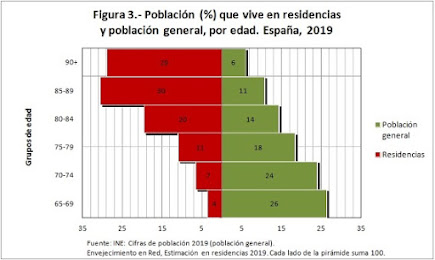The future of Spanish nursing homes. Doubts and opportunities
The global pandemic of covid-19 is leaving a large number of people affected. Due to its characteristics, the most affected population, with a high mortality rate, is the elderly (according to data from the Spanish Ministry of Health, 80% of those who died from the virus were over 70 years of age). This circumstance and the particular situations of each nursing home, which must be analysed with rigour and caution (safety conditions, late reactions, etc.), have led to a reflection on the care and business model for the care of the elderly who require a residential solution.
Of the 5457 centres, 1394 are publicly owned, regardless of management, and 4063 are privately owned. The national average shows the following balance: 74.4% of the homes for the elderly in Spain are privately owned, with an average of 69.8 places per home. Of the total number of places (59.8%) are publicly funded and the rest (40.2%) are privately funded.
Before the pandemic, the future of the care home sector was clear. The care home business was one of the most economically significant in the world. The ageing of the population and the increase in life expectancy augured a rapid and long progression over time that has led to the creation of large groups dedicated to the care of the elderly, ranging from home care to residences for people with major dependencies.
Long-term investment and expansion plans have ground to a halt. Stock prices of major international companies have sufferedlosses. The three big firms in Spain are DomusVi, Orpea and Vitalia. It should not be forgotten that these large companies have centres in several European countries (Orpea, which is listed on the Paris stock exchange, is present in twenty-two countries and has more than 50 establishments in Spain, Domusvi, with French capital, is present in six countries (France, Spain, Portugal, Chile, Uruguay and Colombia) and has 156 residences in our country), and that in all of them the disease has manifested itself in a particularly virulent way in residences for the elderly. This has led to stock market falls and the paralysation of projects.
In Spain, Spanish senior centres had a turnover of more than 4.5 billion (DBK data from 2018) and which has received heavy investment in recent years from private equity. According to data from Savills Aguirre Newman, as of September 2019, investment in retirement homes in Europe as a whole had reached €700 million. The demand for places in these residences is expected to increase by 100 000 units by 2030; in Spain, with its demographic situation, it is reasonable to think that the average coverage for people over 80 years of age, which stands at 13%, is close to the European average, which stands at 18%.
The incidence of the pandemic has been influenced by multiple factors, which is why there are homes that have had hardly any sick residents and others that have been severely affected. These factors include the size of the centres, the architectural design (single or double rooms, layout of common areas, ease of isolating sick or suspicious persons, etc.), the quality of care (ratio of professionals to number of inmates, their training and salaries, available equipment, etc.), and management issues specific to each residence, such as the adoption of rapid and timely measures, the ability to purchase protective and testing equipment and the possibility of having PPEs.
The fact that the facility is located in an affected geographical area also plays a role. The sector argues that the homes are not health centres, but care centres, so they could not provide a service for which they are not prepared and for which they are not required, and there should have been greater agility in the transfer of sick people to hospitals.
In the long term, it is to be hoped that the situation will recover. The global trend towards ageing is a reality that continues unstoppably. However, in the short to medium term the situation may be more complicated. Services will probably have to be reoriented, reorganise care and invest in more staff and materials, restructure centres, invest more in small specialised units and less in macro-centres, etc., even if this results in a lower corporate profit.
A return to normality and pre-crisis occupancy rates will undoubtedly require changes in care models. These changes were already taking place in some countries and some companies were beginning to develop them, with very positive experiences that have been cut short by the health situation.The administrations should also be vigilant in ensuring that the rules are complied with, adjusting legislation as necessary and ensuring that the quality of care rather than the cheapest offer is given priority in the concession of places. This should lead to specifications that prioritise staffing ratios, decent salaries, material conditions and other types of issues rather than economic ones.
The reality indicates that in the future, the nursing home sector, whatever its evolution will continue to be an essential part of the care of the elderly. Thus, it is conceivable that when the situation returns to normal, it will be possible to assume a learning process that will lead to solving problems that until now seemed unsolvable and to new and better ways of caring for the elderly.



Comments
Post a Comment